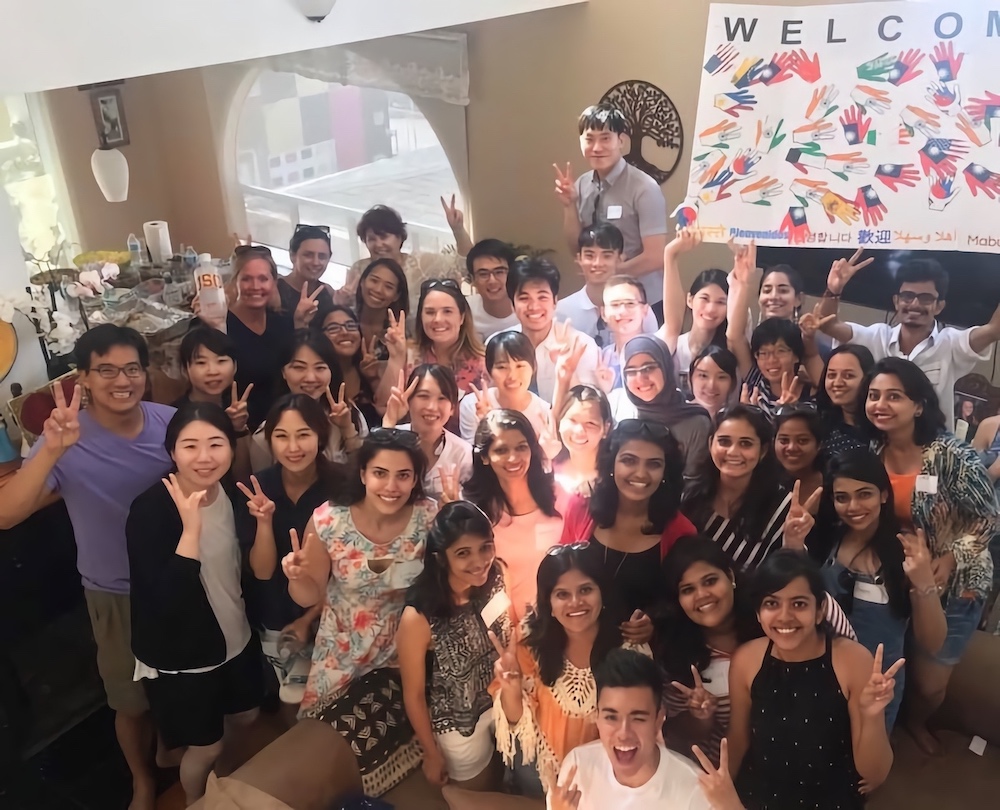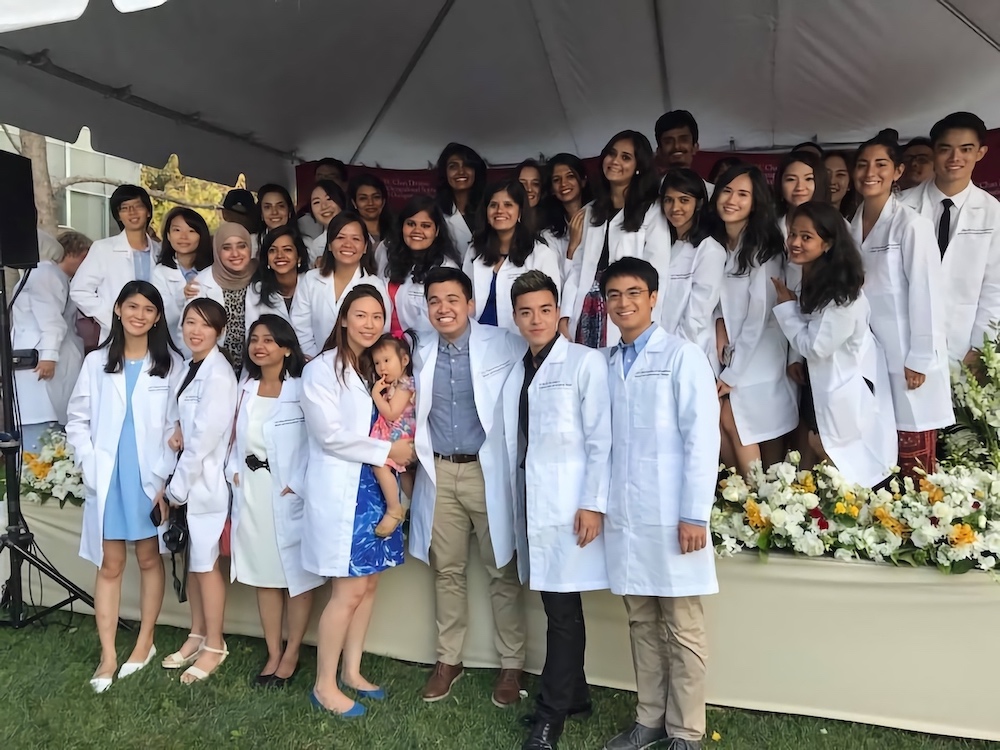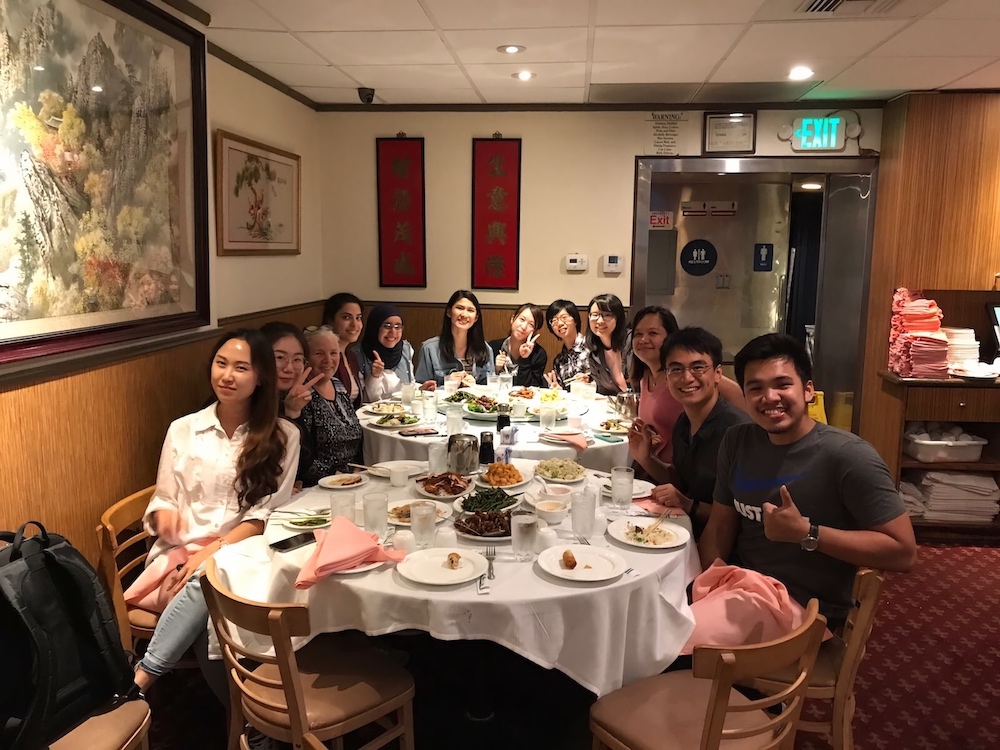Student Blog
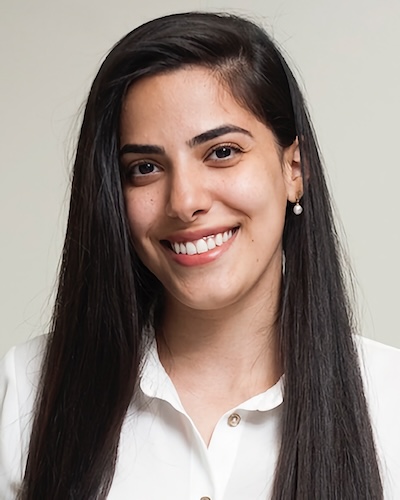
What’s It Like To Be An MA1 Student? ⟩
October 20, 2017, by Linah
One of the unique things about the Post-Professional Program in USC is its own students. Most (if not all) are international students, who either just graduated with an occupational therapy undergraduate degree, or have already worked as OT’s for a while in their own countries. It is a great opportunity for students to connect with occupational therapists from every continent, and learn about how occupational therapy is perceived globally.
Being in the MA1 program and moving to LA was definitely overwhelming in the beginning. Prior to starting this program, I had never crossed the Atlantic before! All I knew about American culture was from Hollywood movies and American media. I had no practical experience about how they do things in this part of the globe. Luckily, this program pays special attention to cultural differences and has dedicated student support programs (like Global Initiatives) to help soften the culture shock.
As soon as I arrived I was invited to a barbeque on the beach at one of the faculty’s homes. It was a great way to get to know some of the faculty who were in attendance, and get familiarized myself with fellow students. We played games on the beach and ate good food, which was wonderful. Definitely was needed after the stress of moving to LA and starting school.
Then to add to the fun, all MA1 students were invited to be part of the White Coat Ceremony. Where each student was presented with their own white coat embroidered with the Chan Division logo. This was a great gesture by the division to induct us into the profession of occupational therapy in the US. It was a cool way to include us into the OT family in USC and make us feel that we are part of it. Especially, that most MA1’s (myself included) come from countries where OT is still emerging. So, they spend more time explaining what OT is than they spend being commended for being part of it. We got to meet each other’s families and mingle with our professors and faculty, which made the day all the more wonderful.
The faculty themselves are such kind individuals, and their hard work to make sure they provide the best education possible really shows. Not only is it obvious during class, but they also invite us to socialize outside of class as well. Dr. Sharon Cermak invited us to dinner at one of her favorite Chinese restaurants in LA. It was good food, good company, and great conversation. Being offered the opportunity to have dinner with one of the 100 most influential people in occupational therapy, is surreal to say the least.
The university really tries to ensure that all of its students are catered to and heard. The support services, financial services, and the free services that students are able to access for just being part of USC! It is a wonderful program to be a part of, and I encourage anyone who sees a master’s in OT in their horizon to look into USC as an option. No need to be intimidated if you’re coming from far away, because everyone here treats you like family.
⋯
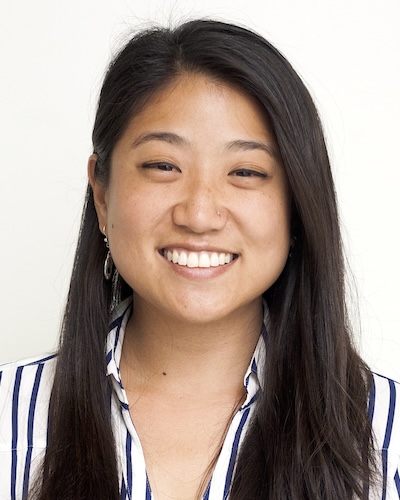
A Day in the Life of a USC Entry-Level Master’s Student ⟩
October 20, 2017, by Erika
Hi all!
Inspired by the Day in the Life of a Chan Student feature on the Division’s website, I thought I’d provide you with a breakdown of what a day may look like for me as a 2nd year Entry-Level Master’s student. My schedule is a little different everyday based on work hours as a student ambassador, my Level I fieldwork placement, and having Fridays off, but here is what a typical day may look like if I had a full day of classes. This is also similar to what a 1st years day would look like since they have the same 2 blocks of time carved out for classes.
A Day in the Life
7:20 — Alarm goes off! Snooze.
7:30 — Wake up! Get ready, make breakfast, pack lunch.
8:15 — Out the door!
8:35 — Look for parking around HSC.
Note: It’s LA! Parking will always be an issue. As a student, you do have the option of purchasing a parking pass on campus. If you choose to opt out of that option, you’ll have to do a bit of a morning hunt like I do to find free parking in the local neighborhood. I would say that after the first few weeks, you’ll get really good at figuring out the best places to park - not to mention know the street cleaning signs by heart! This option also allows for nice morning and afternoon walks to and from your car!
9:00-12:00 — Class
Note: Typically we will get (2) 15 minute breaks to stretch, reset, take a walk. During 1 of the breaks, you’ll probably see me at Eric Cohen Student Health Center getting free coffee, tea, or hot chocolate offered to all USC students!
12:00-1:00 — Lunch
Note: Many times, faculty, student orgs, or the health center may schedule meetings during lunch on various topics: Doctorate or PhD info sessions, Mentor/Mentee lunches, mindfulness classes, yoga on the lawn, etc. If I’m not at one of these, you may see me eating with friends on the patio or practicing transfers with them in the ADL lab.
1:00-4:00 — Class
Note: Afternoon classes can be tough so the free coffee break may happen at this point of the day. Good thing is, since our professors are OTs, they are very attuned to reading when the students are having attention difficulties or hitting an afternoon wall. They’ll break things up, encourage us to stand, take walks, or if we’re in the pediatrics classroom, swing on the swings for some self-regulation!
4:00 and on — Open!
Note: After class, what I do really varies depending on the day. I may have to work in the Student Ambassador office. I may have a meeting for Student Run Clinic. Perhaps I’ll hit up a yoga class, go to Barbara’s at the Brewery with a few friends for a beer, or visit my niece and nephew to play and have dinner! Either way, I find weekday afternoons as opportunities to decompress and chill after a full day of class.
11:30 — #sleepgoals
Thanks for reading! If you have any questions, feel free to write in the comments!
⋯

More Than Just Classes: Interprofessional Geriatric Curriculum Program ⟩
October 16, 2017, by Ali
As part of our course curriculum in the second year, all three cohorts take OT 538: Current Issues in Practice: Adulthood & Aging. This course addresses the shifting demographics of society with the worldwide phenomenon of aging and occupational therapy’s role in caring for the aging population. One option for this course is to engage in an interdisciplinary experience with USC students in other fields of study, which include: pharmacy, dental hygiene, social work, medical, physician assistant, physical therapy, and occupational therapy students! One aspect that drew me into occupational therapy was the potential for interdisciplinary collaboration and community outreach, which this program blends together seamlessly, so I was eager to sign up.
We had our first site visit this week where we prepared for an hour before meeting with our older adult living in the residential community building. The focus of the week was on pharmacy and social work as well as to generally get to know our older adult. My interprofessional team does not include a social work student or a pharmacy student, so the other healthcare professional students and I stepped up to coordinate our session in a collaborative way. We ensured we remained within our respective scopes of practice while also obtaining all the information we needed. The older adult that we get to work with is so welcoming and open about her life.
The different professional students on my team and I took turns asking various questions, about everything from her family, where she is from, what she did for a living, and what she currently does with her time. She was open about her medical history, concerns about age related illness due to family history of diabetes and Alzheimer’s. She showed us photos of her grandchildren and years of travel. She opened up about her peers and how she views aging as something she is in control of by maintaining a social life, physical activity, and engaging in activities that give her life meaning (occupations!).
After the session we debriefed as a team and it was amazing to hear all of the different things that each professional student found significant and would affect their treatment or intervention, if we were to treat our older adult. The physician assistant and the medical student found the vitamins that our older adult is taking to be a great fit for her and her needs. The dental hygienist student noticed a tooth that she was in between appointments on getting it fixed. The physical therapy student noticed bruises on her knees and handles on the walls, which lead her to want to know more about her balance. I wanted to know more about her roles, routines, and habits in order to get a better idea of how she occupies her times.
I love the chance to get to ask each of these different students questions to learn more about their professional lenses as well as the chance to connect with an older adult. Being a student at USC opens the door for opportunities such as this with so many other professional programs and connection to the community. The Trojan family spreads into all of the schools within the university and community members. I look forward to my next site visit to continue my interprofessional growth and building a relationship with our older adult.
⋯
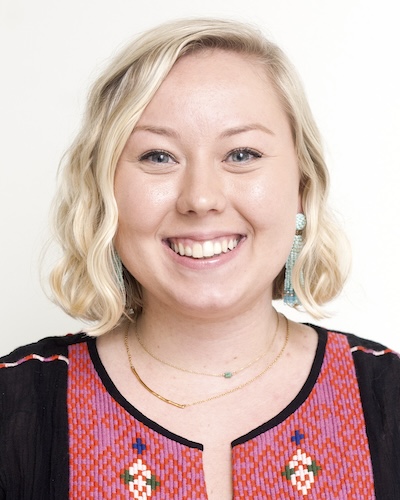
Take a Peek at Pediatrics! ⟩
October 11, 2017, by Caroline
Whenever I give prospective students a tour of our facilities and classrooms during Information Sessions, the Pediatrics classroom tends to get a lot of “oohs” and “aahs.” Rightfully so! Half of the classroom is filled with colorful things to jump on, climb on, swing on, and crash into, which certainly looks a lot more fun than most classrooms I’ve seen! OTs who work in Pediatrics definitely try to make everything they do with their pediatric clients fun and engaging, and the same can be said for our Pediatrics professors. I spend 9 hours each week in my Pediatrics class, but it’s so much more than a lecture with my professors talking at me the whole time! The course integrates team application activities, case studies, and a lot of exploring and trying out different assessment and intervention approaches.
I’ve already told you about my Fieldwork experience in a school-based setting, but now let me give you a peek into my Pediatrics course!
I don’t have pictures for privacy reasons, but we had the opportunity to interact with children and with parents when learning about doing parent interviews and conducting standardized assessments. As a class, we got to practice interviewing a parent of a child who receives OT services, and he was able to give us feedback about how we did. Additionally, professors bring their children into the lab, so we can look at their primitive reflexes and learn about how to conduct standardized assessments. We learned that it’s a lot harder than it looks, but that it becomes easier as you get more familiar with the assessments.

Different snacks used for a grasp analysis activity
When learning about different grasps (how we manipulate our fingers and hands to grab objects) our professors brought in some snacks. Grabbing yummy snacks and bringing them to our mouths was definitely an inherently motivating and fun way to review the various types of grasps. I realized that we grab a sunflower seed differently than we grab something bigger like a cheese-it, which is something I hadn’t thought about before. Next time you’re eating a snack, pay attention to how you pick up your food to eat it!
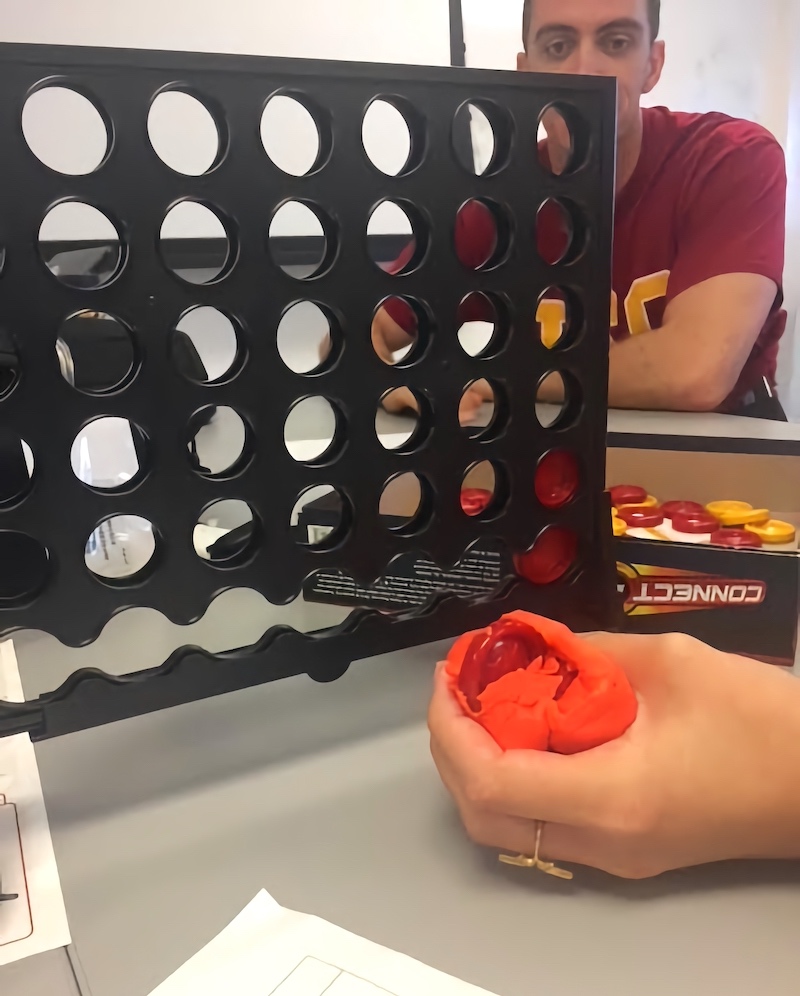
We planned a treatment using Connect 4 and Play-Doh
When practicing planning treatments that address different fine motor skills, our professors put random objects on the table and told us to come up with a fine motor skill treatment using those objects on the spot! My group had play-doh and Connect 4, so we decided to hide the Connect 4 pieces inside the play-doh. That way, by manipulating the play-doh, the child is building up strength in the small muscles in their hands. Then, we can address grasp when looking at how they hold the Connect 4 pieces. We also came up with ways to change the activity to make it more challenging and less challenging. It may look simple, but there’s a lot of thought behind each pediatric treatment!

Lots of different games can be used in OT!
When learning about visuomotor integration (how our vision and perceptual skills work with our fine motor skills to help us interact with our environment efficiently), we got to try out a lot of different games and think about how they could be used in treatment. One of my professors said something that really stuck with me: generally, the children that OTs work with may have a hard time playing a game exactly as it is designed or following the exact direction. This means that it’s the OT’s job to adapt the game and make it the right challenge for each child, allowing them to work on certain skills, but feel successful and have fun at the same time. OT treatment with children can often look like play, but there is a lot of work going on at the same time!

Some of the materials used in the Handwriting Without Tears Program. I practiced using the wooden blocks to put together a few letters!
When learning about handwriting interventions, we got to explore the Handwriting Without Tears program, which aims to do exactly what the name sounds like! For children who have a hard time learning to write or making their writing legible, working on handwriting in therapy could start to feel boring and like work, so a couple of OTs created the Handwriting Without Tears program to make handwriting intervention more dynamic and fun. Children can practice writing on an etch-a-sketch and chalkboards and can form letters with play doh and wooden blocks. This program uses a multisensory approach and has a lot of different options to make treatment fun and different. I’ve used this program used at my fieldwork site, and the kids definitely enjoy it!
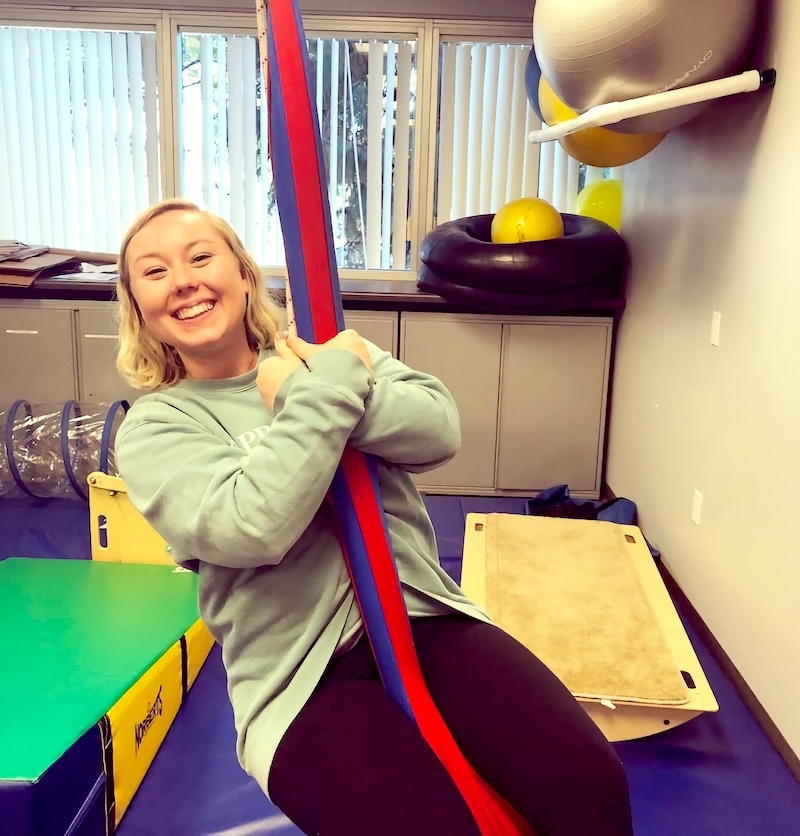
Getting a little vestibular input from one of the swings!
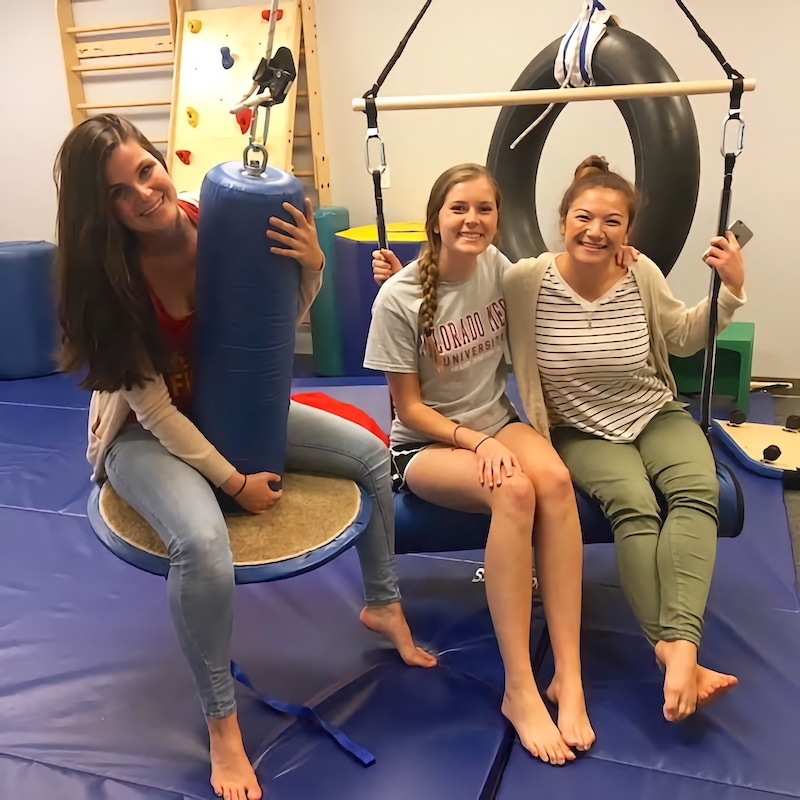
Check out some of my classmates on other swings!
Finally, last week we were learning about Sensory Integration theory and intervention, which was actually developed by A. Jean Ayres, a former OT faculty member here at USC! We learned all about our sensory systems, how they’re supposed to work, what it can look or feel like when they’re not working as they should, and what Sensory Integration can do to help. My professor reminded us that you should always try out an activity yourself before having a child do the activity in therapy, to ensure that it’s the right level of challenge and actually addresses what you want the intervention to address. So, we did exactly that! We explored the lab space and got on different swings and equipment to see what it feels like, how challenging they are, and how our bodies feels afterwards. It was such a fun day!
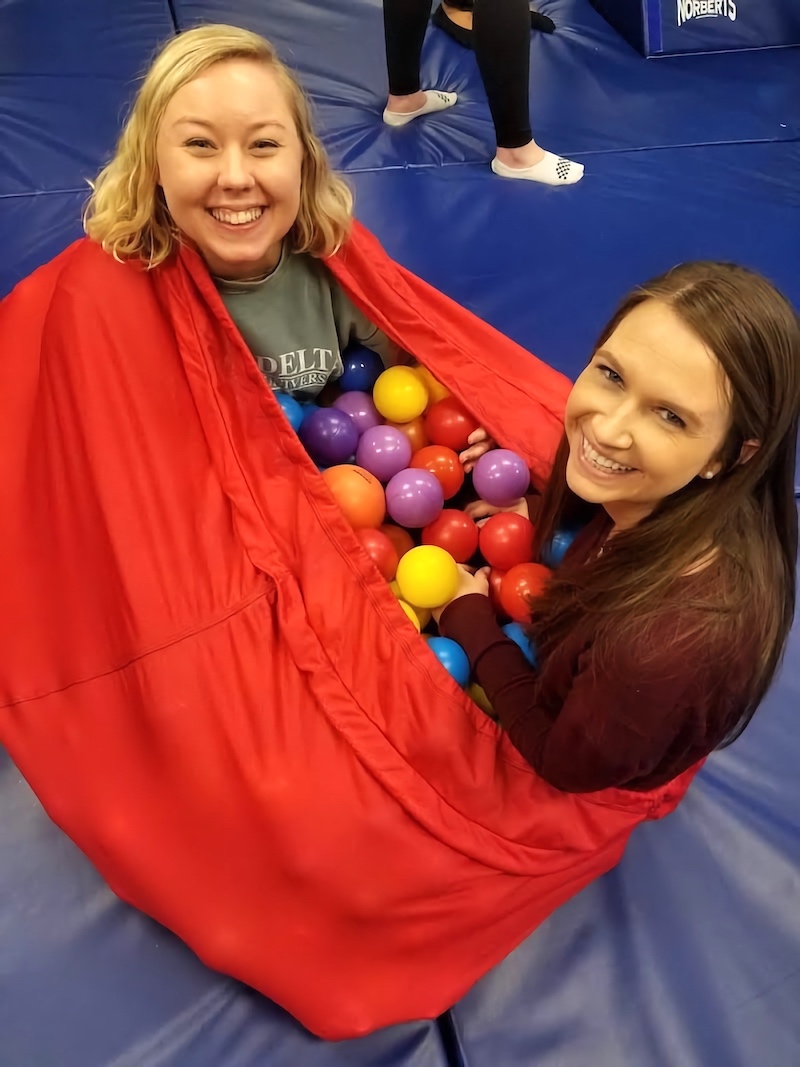
Just two peas in a pod getting some tactile input!
I’m so appreciative of all of the time and effort my professors put in when planning the course and the time spent in the classroom. I’m definitely a learn-by-doing kind of person, so I love when I get to be hands-on in the classroom. My pediatrics midterm is coming up next week, so I’m definitely starting to reflect on everything I’ve learned this first half of the semester. Wish me luck!
⋯

Why Did I Become an Occupational Therapist? ⟩
October 6, 2017, by Linah
Ever since I was little I loved helping people and found value in standing up for those who need it. I grew up in a household of doctors, so I have had a good idea about medicine and loved the science itself. Yet, I never saw myself as doctor. I found occupational therapy by accident. It was a new major in my university and when the time came to choose a specialty, I chose it based on eliminating other medical specialties. I did not know what occupational therapy is until my first class after I majored in it. And ever since, it was a love story for the ages. In occupational therapy I find room to be creative while still validating my ideas with scientific measures. It equips me as a practitioner with the knowledge needed to fully understand a client’s medical problem then provides the tools to find the best solution there is for that particular client.
Through offering customized practical solutions, occupational therapists are able to bridge the gap between culture and medicine on a client by client basis. And what better way is there to help implement change in social attitudes about health and disabilities? Another thing I love about occupational therapy is how it aims to empower its clients. The best way to represent a certain demographic is by enabling them to speak for their own. By educating them about their conditions, rights, and preparing them to face their societies with strength. As an occupational therapist I believe I am capable of doing so. I feel blessed to have found a career as enjoyable, and meaningful as occupational therapy.
⋯






